Related Research Articles
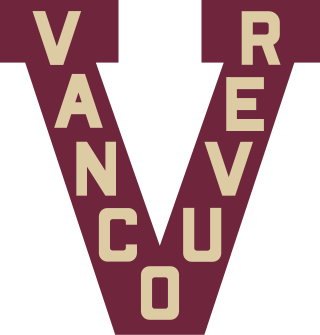
The Vancouver Millionaires were a professional ice hockey team that competed in the Pacific Coast Hockey Association and the Western Canada Hockey League between 1911 and 1926. Based in Vancouver, British Columbia, they played in Denman Arena, the first artificial ice surface in Canada and the largest indoor ice rink in the world at the time it opened.
The Western Canada Hockey League (WCHL), founded in 1921, was a major professional ice hockey league originally based in the prairies of Canada. It was renamed the Western Hockey League (WHL) in 1925 and disbanded in 1926.

The San Francisco Seals were a minor league hockey team which played in the Western Hockey League from 1961 to 1967.
The Pacific Coast Hockey League was an ice hockey minor league with teams in the western United States and western Canada that existed in three incarnations: from 1928 to 1931, from 1936 to 1941, and from 1944 to 1952.
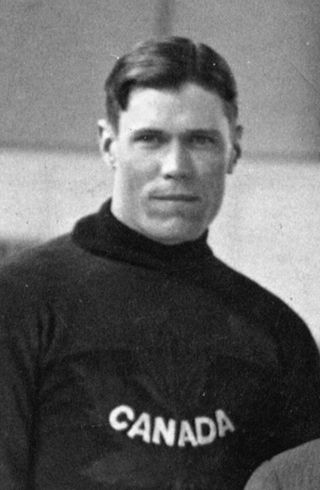
Sigurdur Franklin Fredrickson was an Icelandic-Canadian ice hockey player and aviator. As a player and coach, he was significant to both the amateur and professional ice hockey as it evolved in North America in the early 20th century. Fredrickson's career was interrupted by military service during the First World War and prematurely ended by a knee injury in 1931.
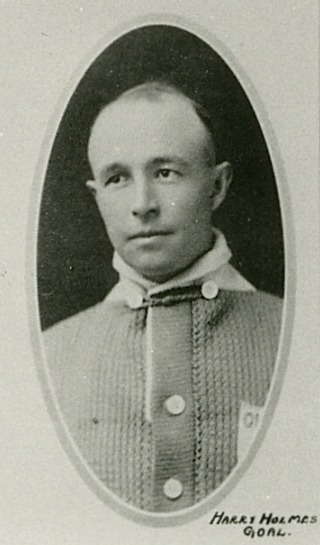
Harry George "Hap" Holmes was a Canadian professional ice hockey goaltender. As a professional, Holmes won the Stanley Cup four times, with four teams. He tied the record of his 1914 Stanley Cup winning Toronto Blueshirts teammate Jack Marshall, who also won Cups with four teams. No other player has duplicated this record.
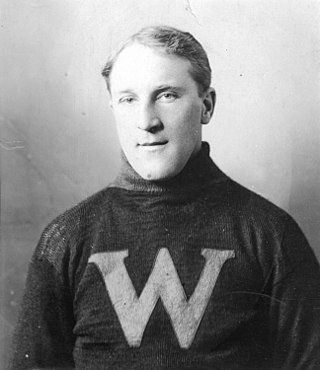
Thomas Ernest "Moose" Johnson, also known as Ernie Johnson, was a Canadian ice hockey player whose professional career spanned from 1905 to 1931. He was a member of four Stanley Cup winning teams between 1905 and 1910 with the Montreal Wanderers of the Eastern Canada Amateur Hockey Association (ECAHA) and later the National Hockey Association (NHA). He moved west, and switched from left wing to defence, in 1911 to join the newly formed Pacific Coast Hockey Association (PCHA). He spent the following decade playing with the New Westminster Royals, Portland Rosebuds and Victoria Aristocrats where he was named a PCHA first-team all-star eight times and played in the 1916 Stanley Cup Finals with Portland.

John Phillip "Jack" Walker was a Canadian professional ice hockey forward who played for the Toronto Blueshirts, Seattle Metropolitans, Victoria Cougars, and Detroit Cougars. He played in all the big professional leagues at the time: the National Hockey Association (NHA), Pacific Coast Hockey Association (PCHA), Western Canada Hockey League (WCHL), and National Hockey League (NHL).

The Cleveland Barons were a professional ice hockey team in the National Hockey League (NHL) from 1976 to 1978. They were a relocation of the California Golden Seals franchise that had played in Oakland since 1967. After just two seasons, the team merged with the Minnesota North Stars. As a result, the NHL operated with 17 teams during the 1978–79 season.

Francis Alexis Patrick was a Canadian professional ice hockey player, head coach, manager, and executive. Along with his brother Lester, he founded the Pacific Coast Hockey Association (PCHA), the first major professional hockey league in Western Canada. Patrick, who also served as president of the league, took control of the Vancouver Millionaires, serving as a player, coach, and manager of the team. It was in the PCHA that Patrick would introduce many innovations to hockey that remain today, including the blue line, the penalty shot, and tracking assists, among others.
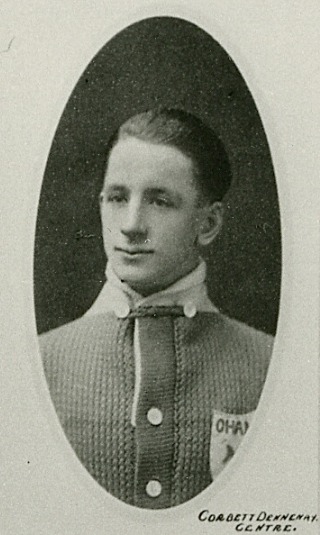
Charles Corbett "Corb" Denneny was a Canadian professional ice hockey forward who played professionally from 1912 to 1931, including nine seasons in the National Hockey League (NHL) for the Toronto Arenas, Toronto St. Pats, Hamilton Tigers and Chicago Black Hawks. Corbett also played for the Vancouver Maroons of the Pacific Coast Hockey Association (PCHA) and the Saskatoon Sheiks of Western Canada Hockey League. He twice won the Stanley Cup with the original versions of the NHL's Toronto franchise.
Ganton Scott was a Canadian ice hockey right winger who played four seasons in the National Hockey League during the 1920s for the Toronto St. Pats, Hamilton Tigers, Montreal Maroons and Toronto Maple Leafs. He also played in the Western Hockey League and the California Hockey League, retiring in 1932 He was born in Little Current, Ontario and died in San Diego, California.

Carol William "Cully" Wilson was an Icelandic-Canadian professional ice hockey player. The right winger played in the National Hockey League (NHL) for the Toronto St. Pats, Montreal Canadiens, Hamilton Tigers, and Chicago Black Hawks between 1919 and 1927. He was also a member of two teams that won the Stanley Cup before the NHL came into existence in 1917, the Toronto Blueshirts and Seattle Metropolitans.

Lloyd Tramblyn "Farmer" Cook was a Canadian professional ice hockey defenceman. He played for the Vancouver Millionaires/Maroons and Spokane Canaries of the Pacific Coast Hockey Association and for the Boston Bruins of the National Hockey League. He won the Stanley Cup in 1915 with the Millionaires and was named to the PCHA first all-star team three times.

Norman Boswell "Hec" Fowler was a two-sport athlete from Canada. He was a professional ice hockey goaltender who played in the Pacific Coast Hockey Association and National Hockey League between 1916 and 1925. He was also a soccer goalkeeper for Saskatoon Thistle.

Thomas Wilfred "Smokey, Fred" Harris was a Canadian professional ice hockey player. Harris played in the Pacific Coast Hockey Association (PCHA), the National Hockey League (NHL) and the Western Canada Hockey League (WCHL). Harris was born in Port Arthur, Ontario. His brother Henry was also a professional ice hockey player. Harris scored the first goal in Boston Bruins' franchise history.

Thomas Robinson Murray was an American-Canadian professional ice hockey goaltender who played in various professional and amateur leagues, including the Western Canada Hockey League (WCHL) and Pacific Coast Hockey Association (PCHA).

The Los Angeles Monarchs were a professional ice hockey team, active from 1944–1950, in the Pacific Coast Hockey League (PCHL). The Monarchs are the first professional ice hockey team to win a league championship for the city of Los Angeles. They played in the southern division of the PCHL, alongside teams from the neighboring cities such as the Pasadena Panthers, the Hollywood Wolves, and the San Diego Skyhawks. The southern division also included the San Francisco Shamrocks, Oakland Oaks and, in 1947, the Fresno Falcons.
The Palais de Glace in Los Angeles, California was an indoor, artificial ice rink. The venue was the first artificial ice rink in Southern California and served the community until it was destroyed by fire in 1934.